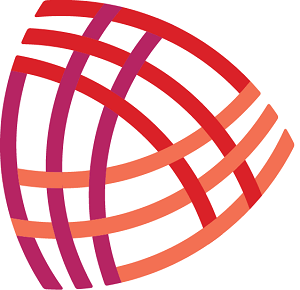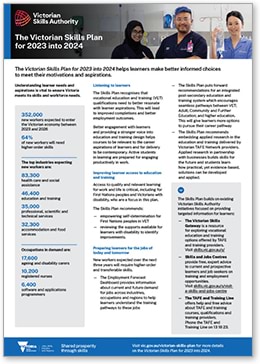This fact sheet provides summary information about the Victorian Skills Plan 2023 into 2024 specifically related to learners.
You can download a PDF copy or read an accessible version below.
Also see our other fact sheets related to the plan.
Downloadable learner fact sheet
(opens in a new window)
Accessible learner fact sheet
The Victorian Skills Plan for 2023 into 2024 helps learners make better informed choices to meet their motivations and aspirations
Understanding learner needs and aspirations is vital to ensure Victoria meets its skills and workforce needs.
Key statistics from the Victorian Skills Plan for 2023 into 2024
- 352,000 new workers expected to enter the Victorian economy between 2023 and 2026
- 64% of new workers will need higher-order skills.
The top industries expecting new workers
- 83,300 health care and social assistance
- 46,400 education and training
- 35,000 professional, scientific and technical services
- 32,300 accommodation and food services.
Occupations in demand
- 17,600 ageing and disability carers
- 10,200 registered nurses
- 6,400 software and applications programmers.
More information on Victoria’s employment needs is available in the State of the Victorian Labour Market Report 2023.
Listening to learners
The skills plan recognises that vocational education and training (VET) qualifications need to better resonate with learner aspirations. This will lead to improved completions and better employment outcomes.
Better engagement with learners and providing a stronger voice into education and training design helps courses to be relevant to the career aspirations of learners and for delivery to be contemporary. Active students in learning are prepared for engaging productively in work.
Improving learner access to education and training
Access to quality and relevant learning for work and life is critical, including for First Nations peoples and Victorians with disability, who are a focus in this plan.
The skills plan recommends:
- empowering self-determination for First Nations peoples in VET
- reviewing the supports available for learners with disability to identify improvements.
Preparing learners for the jobs of today and tomorrow
New workers expected over the next three years will require higher-order and transferable skills.
- The Employment Forecast Dashboard provides information about current and future demand for jobs across industries, occupations and regions to help learners understand the training pathways to these jobs.
- The skills plan puts forward recommendations for an integrated post-secondary education and training system which encourages seamless pathways between VET; Adult, Community and Further Education; and higher education. This will give learners more options to pursue their career pathway.
- The skills plan recommends embedding applied research in the education and training delivered by Victorian TAFE Network providers. Applied research in partnership with businesses builds skills for the future and students learn how practical, yet evidence-based, solutions can be developed and applied.
Resources
The skills plan builds on existing Victorian Skills Authority initiatives focused on providing targeted information for learners:
- The Victorian Skills Gateway(opens in a new window) is a resource for exploring vocational education and training options offered by TAFE and training providers.
- Skills and Jobs Centres provide free, expert advice to current and prospective learners and job seekers on training and employment opportunities.
- The TAFE and Training Line provides free information about TAFE and training courses, qualifications and training providers.
- Phone 13 18 23 from 8.30am to 4.30pm, Monday to Friday (closed on public holidays)
- Email tafe.courseline@djsir.vic.gov.au
Updated


